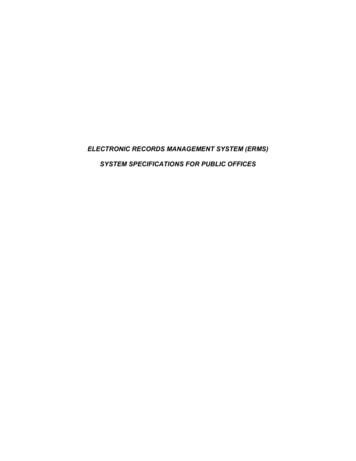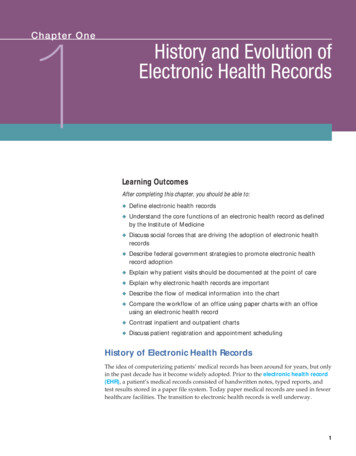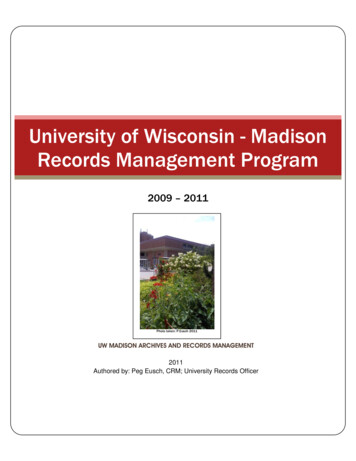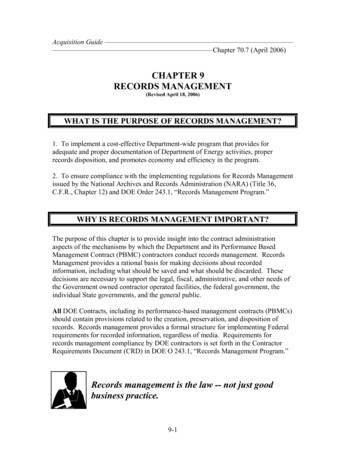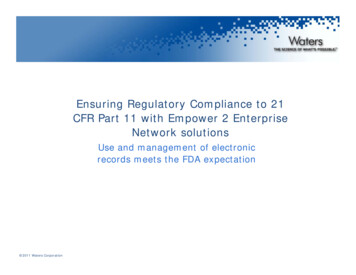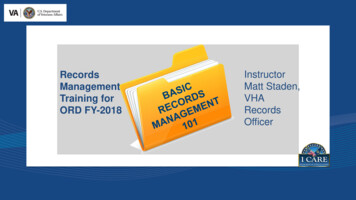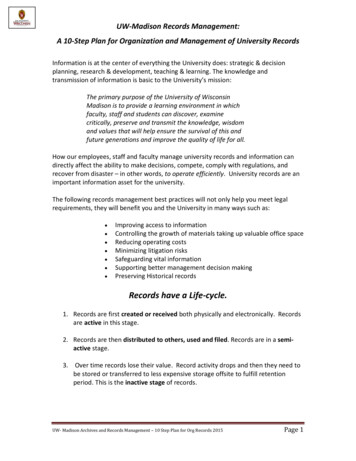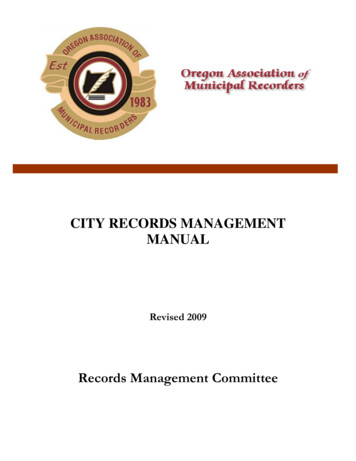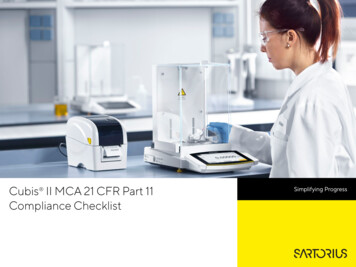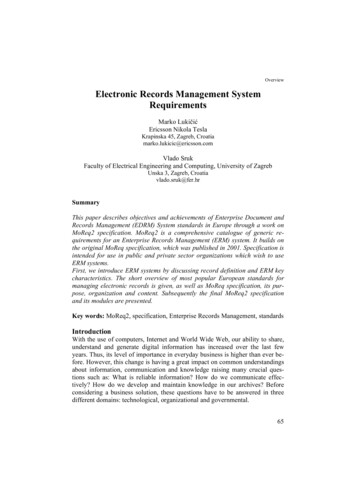
Transcription
OverviewElectronic Records Management SystemRequirementsMarko LukičićEricsson Nikola TeslaKrapinska 45, Zagreb, Croatiamarko.lukicic@ericsson.comVlado SrukFaculty of Electrical Engineering and Computing, University of ZagrebUnska 3, Zagreb, Croatiavlado.sruk@fer.hrSummaryThis paper describes objectives and achievements of Enterprise Document andRecords Management (EDRM) System standards in Europe through a work onMoReq2 specification. MoReq2 is a comprehensive catalogue of generic requirements for an Enterprise Records Management (ERM) system. It builds onthe original MoReq specification, which was published in 2001. Specification isintended for use in public and private sector organizations which wish to useERM systems.First, we introduce ERM systems by discussing record definition and ERM keycharacteristics. The short overview of most popular European standards formanaging electronic records is given, as well as MoReq specification, its purpose, organization and content. Subsequently the final MoReq2 specificationand its modules are presented.Key words: MoReq2, specification, Enterprise Records Management, standardsIntroductionWith the use of computers, Internet and World Wide Web, our ability to share,understand and generate digital information has increased over the last fewyears. Thus, its level of importance in everyday business is higher than ever before. However, this change is having a great impact on common understandingsabout information, communication and knowledge raising many crucial questions such as: What is reliable information? How do we communicate effectively? How do we develop and maintain knowledge in our archives? Beforeconsidering a business solution, these questions have to be answered in threedifferent domains: technological, organizational and governmental.65
INFuture2009: “Digital Resources and Knowledge Sharing”Challenges in the technological domain have to cope with problems of manipulating and securing massive volumes of geographically distributed businesscritical and sensitive data. Organizational challenges include reform of businessprocesses and ways of handling and storing paper documents in classical archives. To enable an archive to be aware of digital data and to take over retention, management, retrieval and disposal processes of electronic data, it is necessary to redefine user roles and its responsibilities too. Challenges in the governmental domain present the greatest obstacle in implementing an electronicarchive. Its critical task is to ensure legality and trustworthiness of digital datain respect to legislative and regulative.The key benefits of the electronic archives are well known. Data can be easilyand centrally managed and secured. The digital form of documents eliminatescosts of physical storage because it doesn’t require special necessities as largepersonnel, big rooms secured from fire, flood, freezing or high temperature thatcould cause the occurrence of fungi, etc., and it bypasses the barriers of distributed offices. However, the main reason of implementing a digital archive is toachieve pure electronic business backbone. A business information systembased on electronic archive enables organizations to automate the whole processfrom data acquisition or generation, to its processing, classification and archivalas a true and legal evidence of business activity1.The Enterprise Records Management (ERM) systems are designed as a result ofthis necessity. Its main purpose is to provide a backbone for building the digitalarchive capable of managing electronic and physical records. Main functions ofERM systems are: content creation and capture, storing content, content retrieval, short- and long-term preservation and content disposition and disposal.Today, such systems have become necessary for forming the electronic writingoffice, also known as the paperless office23. The key role of ERM systems is toreduce the response times for information requests, eliminate paper redundancyand duplication, and finally remove paper from the records management cyclewhile maintaining legality and trustworthiness of digital data in respect to legislative and regulative.1Cornu, Jean-Michel. DLM-Forum. Guidelines on best practices for using electronic information.Office for Official publications of the European Communities. ISBN:92-828-2285-0. Luxembourg. 1997.2Baumann, Stephan; Malburg, Michael; Meyer Auf’m Hofe, Harald; Wenzel, Claudia. From paper to a corporate memory. KI-97 Workshop on KBS for Knowledge Management in Enterprises.Freiburg, Germany. 1997 Sep 9-12; p. 16.3Volarevic, Marijo; Strasberger, Vito; Pacelat, Elvis. A Philosophy of the Electronic DocumentManagement. Proc. of the 22nd International Conference on Information Technology Interfaces;2000 Jun 13-16; Pula, Croatia. Zagreb: SRCE University Computing Centre, University of Zagreb; 2000. p. 141-146.66
M. Lukicic, V. Sruk, Electronic Records Management System RequirementsEnterprise Records Management SystemsThere is no general definition what ERM systems are. Nowadays, definitionsare mainly short descriptions of products for managing electronic records defined by the enterprise content management system vendors. However, ERMfunctionalities are mainly dictated by requirements defined by the national archives. And these requirements are results of long evolution and tradition inmanaging and organizing physical records in archives. Thus, differences between particular ERM systems are mainly in algorithm realization (ex. securityalgorithms), technology support (ex. integration with other systems) and in additional functionalities (ex. extended object model). Still, there is one documentthat has become most referenced in recent years when considering ERM systemdefinition: ISO 15489-1:2001 (ISO) standard4.RecordThe ISO 15489-1 standard defines a record as: „recorded information, in anyformat, that is created, received and maintains as evidence and information byan organization or person, in pursuance of legal obligations or in the transactionof business“. There are two key points that must be noted in ISO 15489-1 definition of a record. First, definition is opened for all types of records (ex. digitalrecords, paper records, physical objects, etc.). And second, record is an evidence of business action, transaction or any other activity (ex. contract).By ISO definition, to be authoritative, records must be: Authentic (ex. to have been created or send by the purported person); Reliable (trusted contents which accurately reflect the documented activity); Have integrity (records must be complete and unaltered); Useable (records can be located, retrieved, presented and interpreted).It is important to recognize similarities and differences between documents andrecords as shown in Table 1.Table 1: Differences between documents and records.DocumentRecordA “piece” of information you canhandle or manageMay be important, or notUnder the management of its “owner”(usually author)Can be changed at willCan be deleted at willA “piece” of information you canhandle or manageRepresents important evidence ofdecision or actUnder corporate managementCannot be changedCannot usually be deleted4ISO 15489: Information and documentation – Records management. Reference number: ISO15489-1:2001(E). International Organization for Standardization. 2001.67
INFuture2009: “Digital Resources and Knowledge Sharing”Records ManagementBesides records, ISO 15489-1 standard defines records management as: “thefield of management responsible for the efficient and systematic control of thecreation, receipt, maintenance, use and disposal of records, including processesfor capturing and maintaining evidence of an information about business activities and transactions in the form of records.“ERM systems are systems that ensure management of records (as defined inISO records management definition), whether they are in electronic of physicalformat, while ensuring all records characteristics (as defined in ISO record definition). By the ISO standard, ERM systems should provide: Reliability of complete, organized, accessible and protected records; Protected integrity by authority control systems; Compliance with legislative, regulative and appropriate businessrequirements; Reflected comprehensive range of appropriate business activities; Systematic creation, preservation and management of records.Figure 1: The Document and Record lifecycle in an ECM environment.Nowadays, ERM systems are usually integrated with an Electronic DocumentManagement (EDM) system to form an Enterprise Document and RecordsManagement (EDRM) system. Synergy of those two systems combines document oriented collaboration functionalities of EDM systems with classification,compliance, preservation and disposition and disposal functionalities of ERMsystems. Business Process Management (BPM) systems may be used as abridge between a case file in ERM system and appropriate case file workflow.68
M. Lukicic, V. Sruk, Electronic Records Management System RequirementsOther technologies such as electronic forms (eForms) can be used as additionaltools for user interface customization and records capture automation.ERM (or EDRM) systems typically fall in Enterprise Content Management(ECM) system – system for managing all organizational information assets overtheir lifecycle, Figure 1.Records management standardsAlthough national archives indirectly shape functionalities of ERM systems,there are still pending functionality problems to be solved. The main problem isdifferences in practices between national archives of different countries. Despitethe similarity of records management practices among European Union (EU)countries, there are still minor dissimilarities, which require individual implementation of specific functionality5.Moreover, almost every EU country has prescribed its own standard for recordsmanagement. Because of non-existent records management standard at EUlevel, major ERM vendors mainly choose to certify its ERM systems for BritishPRO/TNA standard only. This retarded digitization of archives, and indirectlyimplementation of true electronic businesses, in smaller EU countries.In continuation, we bring the short overview of most popular records management standards in EU countries.DOMEA (Germany)6. DOMEA concept (Document Management and Electronic Archiving in Electronic Business, also known as “Paperless Office Concept”) is the most important guideline for the implementation of electronic records in Germany. It consists of three main sections: Organization concept, Requirements catalogue and expansion modules. Although IT vendors are not obligated to certify its ERM systems against DOMEA, there are 170,000 approvedDOEMA licenses in Germany, Austria and Switzerland.ELAK (Austria)7. ELAK (Electronic Act) is a program of the Austrian FederalGovernment for a simplification and consolidation of the federal internal management of records. In addition to DOMEA, the ELAK concept describes requirements and functions of the ERM systems in more technical detail. Moreover, it provides examples what has to be considered in invitations for publictenders.5PICTURE consortium. Integrating and Strengthening the European Research Area. ICT Research for Innovative Government. Project No 027717. PICTURE consortium. 2007.6Bundesministerium des Innern. DOMEA Concept. Organisational Concept 2.0. Document Management and Electronic Archiving in Electronic Courses of Business. Koordinierungs- und Beratungsstelle der Bundesregierung fur Informationstechnik in der Bundesverwaltung, KBSt. ISSN0179-7263. November 2005.7Bundesministerium fur offentliche Leistung und Sport. ELAK-Konzept. Funktionsbeschreibung.November 2001. 86/default.aspx69
INFuture2009: “Digital Resources and Knowledge Sharing”Gever (Switzerland)8. The Swiss Gever is collection of five standards that introduces management of electronic records and paper based records administration abandonment. The five standards are: Business Administration, Methodsand functions with regard on legal defaults, Business model GEVER Federation, Service catalogue of GEVER applications and GEVER metadata.Protocollo Informatico/CNIPA (Italy)9. CNIPA (National Centre for Information Technologies in Public Administration) is the government organization responsible to give support to the Italian public administrations in creating information systems to further improve the quality of services and keep the administrative costs down. Protocollo Informatico is published by CNIPA that describesthe electronic protocol as a framework of resources used by administrations formanaging documents.ReMANO (Netherlands)10. ReMANO is a catalogue of software specificationsfor ERM systems in Duch government bodies. It is published in 2004 by “Nederlands Instituut voor Archiefonderwijs en – onderzoek”.NOARK (Norway)11. NOARK-4 is functional requirements specification forERM and case management systems used in all public authorities in Norway.PRO/TNA (United Kingdom)12. The PRO/TNA document is developed byPublic Records Office (The National Archive). Its main purpose is to provide atool for benchmarking ability of government departments to support electronicrecords management. Although, PRO/TNA was the most comprehensive andpopular standard in EU, it is replaced with MoReq specification.MoReq specificationThough there are a large number of records management national standards inEU, the absence of the EU-wide standard complicates an interoperable deliveryof European electronic government services to public administrations, businessand citizens. This was in confrontation with i2010 eGovernment Action Plan8eCH, eGovernment-Standards. eCH-0037 Hilfsmittel GEVER Vorgaben Bund. Verein eCH.April 2005.9Centro Nazionale per l'Informatica nella Pubblica Amministrazione, CNIPA. Protocollo informatico. CNIPA. URL: rotocollo informatico/10Nederlands Instituut voor Archiefonderwijs en – onderzoek. Softwarespecificaties voor Records Management Applicaties voor de Nederlandse Overheid (ReMANO). Archiefschool. Mart2004.11Riksarkivet - The National Archives of Norway. Norwegian recordkeeping system, Version 4(NOARK). Functional description and specification of requirements. Riksarkivet. 2000.12Public Record Office, United Kingdom. Requirements for Electronic Records ManagementSystems. The National Archives. 2002.70
M. Lukicic, V. Sruk, Electronic Records Management System Requirementswhich one of main objectives is to accelerate the delivery of tangible benefitsfor citizens and business through eGovernment13.The need for a comprehensive specification of ERM system requirements forgovernment authorities was first articulated by DLM Forum in 1996. DLM Forum (Donnees Lisibles par Machine) is a multi-disciplinary forum constitutedby European Commission. Its main goal is to investigate, promote and implement - in close cooperation with Member States - possibilities for wider cooperation in the field of electronic archives both between the Member States andat EU level.In 1999 DLM Forum issued the following action point: development of a reference model for managing electronic documents and records in public administration.The work on specification began in 2000 and it was completed in 2001. MoReq,first became available electronically in 2001, was published by the EuropeanCommission as an INSAR (Information Summary on Archives publication)supplement in early 2002.The specification contains functional and non-functional requirements for ERMsystems. Functional requirements cover following topics: overview of ERMsystem functionalities, classification scheme, control and security, retention anddisposal, capturing records, search, retrieval and rendering, administrativefunctionalities and other functionalities. Non-functional requirements, such asthe metadata model, can vary enormously between environments. Thus, MoReqspecification identifies and describes non-functional requirements only in outline.The specification suggests that ERM system should be introduced not only toAdministrators and Archivists (that is, staff responsible for records management), but to all general offices and operational staff that are involved in a creation, receiving and retrieving of the records. Therefore, MoReq specificationembraces records management closely-related requirements such as documentand case management. However, these requirements are described in less detailthan functional requirements.Because of its comprehensiveness, MoReq becomes accepted and used worldwide. However, some problems have been raised in the last few years. The mainproblem is that MoReq is not a formal standard but a guideline. Non-existenceof the testing regime disables ERM system vendors to provide conceivableproof of MoReq compliance. Furthermore, there has been no advancement since2001. Technology has moved on. And the lack of governance caused uncontrolled MoReq translations referenced in particular ERM systems. Somethinghad to be done.13European Communities. i2010 eGovernment Action Plan. Communication from the Commission, of 25 April 2006, i2010 eGovernment Action Plan - Accelerating eGovernment in Europefor the Benefit of All. 2006. http://europa.eu/scadplus/leg/en/lvb/l24226j.htm71
INFuture2009: “Digital Resources and Knowledge Sharing”The MoReq2 projectThe revision of MoReq specification was proposed by Ian MacFarlane in “Plansfor MoReq, a report on scoping of a MoReq 2” paper14. This document containskey conclusions of DLM Forum discussion about MoReq revision. In 2006,DLM Forum published “Scoping report for the development of the Model Requirements for the management of electronic records (MoReq2)”. This document outlines details of changes in the old document. The overall aims for theMoReq2 development, as described in Scoping report, are to develop extendedfunctional requirements within a European context, and to support a compliancescheme by: Strengthening from MoReq what have in the interim become key areasand covering important new areas of requirements with clarity; Ensuring that the functional requirements are testable and developing testmaterials to enable products to be tested for compliance with the requirements; Making the requirements modular to assist application in the various environments in which they will be used.As stated in the report, to provide compatibility with earlier version, MoReq2 isto be an evolutionary update to the original MoReq, not a radically differentproduct.The MoReq2 project started in 2007, and the MoReq2 specification is formallypublished at the beginning of 2008.MoReq2 specificationThe MoReq2 specification is a collection of required and optional functionaland non-functional requirements for the ERM systems. While required functionalities are mandatory for MoReq2 compliance, optional requirements correspond for desirable but not mandatory characteristics of the ERM systems.Required and optional requirements are grouped in core module (mandatorymodule for MoReq2 compliance) and optional modules (ERM system providersmay choose to additionally certify software for particular optional modules).Core module contains requirements regarding classification scheme and file organization, controls and security, retention and disposition, capturing and declaring records, referencing, searching, retrieval and presentation, and ERMsystem administration.Optional modules are: Management of Physical (Non-electronic) Files and Records, Disposition of Physical Records, Document Management and Collaborative Working, Workflow, Casework, Integration with Content Management Systems, Electronic Signatures, Encryption, Digital Rights Management,14Ian MacFarlane. The Plans for MoReq (Model requirements for the management of electronicrecords): A Report on the Scoping of the MoReq2. DLM Forum Conference. Budapest. 2005.http://ec.europa.eu/transparency/archival policy/dlm forum/doc/12 macfarlane 06-10-05am.pdf.72
M. Lukicic, V. Sruk, Electronic Records Management System RequirementsDistributed Systems, Offline and Remote Working, Fax Integration and Security Categories15.The metadata requirements present another important part of MoReq2 specification. MoReq2 metadata, based on Dublin Core Metadata Element Set, includes indexing information and other data needed for effective records management, such as access restriction information. As is not possible to define allthe metadata requirements for all possible kinds of ERMS implementation,MoReq2 suggests minimum requirements, which are intended as the startingpoint for customization and expansion. These minimum requirements areclosely related to lists of specific metadata “elements” which the ERM systemsmust be able to capture and process.Figure 2: MoReq2 entity-relationship model.15Cornwell Affiliates plc. Model Requirements for the management of electronic records.MoReq2 specification. Office for Official publications of the European Communities as INSARsupplement VIII. Bruxelles. Luxembourg. 2008.73
INFuture2009: “Digital Resources and Knowledge Sharing”Sub-files and components are new entities added to the MoReq object model,Figure 2. Sub-file is an intellectual subdivision of a file. It is often used in casemanagement environments. Typical examples of sub-files are “invoices”, “assessments” and “correspondences”. Component is a bit stream that, alone orcombined with other bit streams, makes up a record or document. Typical example of a component is a JPEG image of an HTML document.Hybrid file, file that contains electronic and physical records, is omitted fromobject model. Therefore MoReq2 allow classes, files, sub-files and volumes tocontain electronic records and physical records together, in any combination.A special care was taken regarding specification localization. As each countrymay have need for specific requirements regarding managing electronic records,in MoReq2 structure is imbedded “Chapter zero”. This chapter can be used torepresent specific needs of a particular country. The only restriction on expanding MoReq2 specification with this chapter is that content of the chaptershould not contradict the content of the rest of MoReq2.ConclusionWith the increase of produced information and wide diversity of informationformats, challenges for the management of electronic records have never beengreater. To cope with implementations of new technologies and to achievetrustworthy of digital records in respect to legislative and regulative, particularcountries started introducing specifications regarding managing of electronic records. However, multiplicity of different specifications makes interoperabilityof data between administrations of EU countries difficult.MoReq2 represents a step forward in the process of unifying records management software standards and practices across Europe. It provides governmentsand corporations a single approach to managing their most important records.Thus, MoReq2 will significantly contribute to the accomplishment of greaterinteroperability between administrations, business and citizens, that is theachievement of the goals of the Europe Union’s i2010 eGovernment actionplan.ReferencesBaumann, Stephan; Malburg, Michael; Meyer Auf’m Hofe, Harald; Wenzel, Claudia. From paperto a corporate memory. KI-97 Workshop on KBS for Knowledge Management in Enterprises.Freiburg, Germany. 1997 Sep 9-12; p. 16.Bundesministerium des Innern. DOMEA Concept. Organisational Concept 2.0. Document Management and Electronic Archiving in Electronic Courses of Business. Koordinierungs- undBeratungsstelle der Bundesregierung fur Informationstechnik in der Bundesverwaltung,KBSt. ISSN 0179-7263. November 2005.Bundesministerium fur offentliche Leistung und Sport. ELAK-Konzept. Funktionsbeschreibung.November 2001. 86/default.aspxCentro Nazionale per l'Informatica nella Pubblica Amministrazione, CNIPA. Protocollo informatico. CNIPA. URL: rotocollo informatico/74
M. Lukicic, V. Sruk, Electronic Records Management System RequirementsCornu, Jean-Michel. DLM-Forum. Guidelines on best practices for using electronic information.Office for Official publications of the European Communities. ISBN:92-828-2285-0. Luxembourg. 1997.Cornwell Affiliates plc. Model Requirements for the management of electronic records. Office forOfficial publications of the European Communities as INSAR supplement VI. ISBN:92-8941290-9. Bruxelles. Luxembourg. 2001.Cornwell Affiliates plc. Model Requirements for the management of electronic records. MoReq2specification. Office for Official publications of the European Communities as INSAR supplement VIII. Bruxelles. Luxembourg. 2008.eCH, eGovernment-Standards. eCH-0037 Hilfsmittel GEVER Vorgaben Bund. Verein eCH.April 2005.European Communities. i2010 eGovernment Action Plan. Communication from the Commission,of 25 April 2006, i2010 eGovernment Action Plan - Accelerating eGovernment in Europe forthe Benefit of All. 2006. n MacFarlane. The Plans for MoReq (Model requirements for the management of electronic records): A Report on the Scoping of the MoReq2. DLM Forum Conference. Budapest. 2005.http://ec.europa.eu/transparency/archival policy/dlm forum/doc/12 macfarlane 06-1005am.pdf.ISO 15489: Information and documentation – Records management. Reference number: ISO15489-1:2001(E). International Organization for Standardization. 2001.Nederlands Instituut voor Archiefonderwijs en – onderzoek. Softwarespecificaties voor RecordsManagement Applicaties voor de Nederlandse Overheid (ReMANO). Archiefschool. Mart2004.PICTURE consortium. Integrating and Strengthening the European Research Area. ICT Researchfor Innovative Government. Project No 027717. PICTURE consortium. 2007.Public Record Office, United Kingdom. Requirements for Electronic Records Management Systems. The National Archives. 2002.Riksarkivet - The National Archives of Norway. Norwegian recordkeeping system, Version 4(NOARK). Functional description and specification of requirements. Riksarkivet. 2000.Volarevic, Marijo; Strasberger, Vito; Pacelat, Elvis. A Philosophy of the Electronic DocumentManagement. Proc. of the 22nd International Conference on Information Technology Interfaces; 2000 Jun 13-16; Pula, Croatia. Zagreb: SRCE University Computing Centre, Universityof Zagreb; 2000. p. 141-146.75
Systematic creation, preservation and management of records. Figure 1: The Document and Record lifecycle in an ECM environment. Nowadays, ERM systems are usually integrated with an Electronic Document Management (EDM) system to form an Enterprise Document and Records Management (EDRM) system. Synergy of those two systems combines docu-
